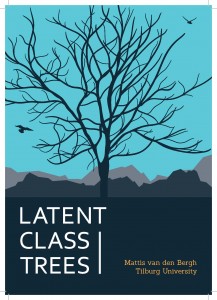 Methodology and Statistics
Methodology and Statistics
Tilburg School of Social and Behavioral Sciences
Tilburg University
Supervisors
Prof. J.K. Vermunt & Dr V.D. Schmittmann
On January 5th, 2018, Mattis van den Bergh defended his thesis entibled
 Summary
Summary
Latent Class Analysis is used to identify unobserved homogeneous groups within a data set. However, it can be quite difficult to determine the number of classes. Often the number of classes is expanded by estimating a new model with more classes until some fit measure does not improve further with the addition of more classes. However, it can be very hard to have a substantive argument for the number of classes, while different fit measures can indicate a different optimal number of classes. Moreover, when a fit measure indicates a number of classes that is much larger than desired by the researcher this number is often reduced to still have interpretable classes. This completely ignores the fit of the model. With Latent Class Tree analysis there are more options for substantive argumentation of the number of latent classes because the number of classes is expanded by splitting classes and therefore the conditional independence assumption is met in a stepwise manner. This results in a hierarchical tree structure of latent classes.
Project
Divisive latent class modeling
Latent class (LC) analysis is used by social and behavioral scientists as a statistical method for building typologies, taxonomies, and classifications based on a set of observed characteristics. Examples include attitudinai typologies of citizens based on survey questions measuring their attitudes toward freedom of speech, subtypes of schizophrenia patients derived from recorded mood symptoms, classifications of developmental stages of children based on tests taken at different ages, taxonomies of delinquent youths derived from criminal records, classifications of consumers inferred from stated or revealed preferences, and taxonomies of temporal project networks based on characteristics of these projects and the related organizations.
Because of the obvious usefulness of these methods, during the last two decades, there has been an impressive increase in LC appücations in social and behavioural sciences. Yet, because of the technical expertise required, the vast majority of the researchers experience difficulties applying LC methods correctly despite the wide availabiJity of user-friendly software. The aim of this VICI project is to resolve this problem through the development of easy to use stepwise model-fitting methods for LC analysis.
Each of the three main parts of the proposed project examines the application of stepwise methods in an important area where such new approaches are needed; that is, in 1) traditional modeling, 2) model adjustments, and 3) hierarchical modeling. Part 1 develops diagnostics for testing the key LC model assumptions, and ïnvestigates how these can be used for stepwise model building in simple and complex LC analysis. Part 2 expands recently proposed adjustment methods needed when using assigned class mernberships in a next step of the data analysis. Part 3 studies the possibility of applying LC models in a manner similar to hierarchical cluster analysis, where in each step the solution from the previous step is refined.
Financed by
NWO – Vici
